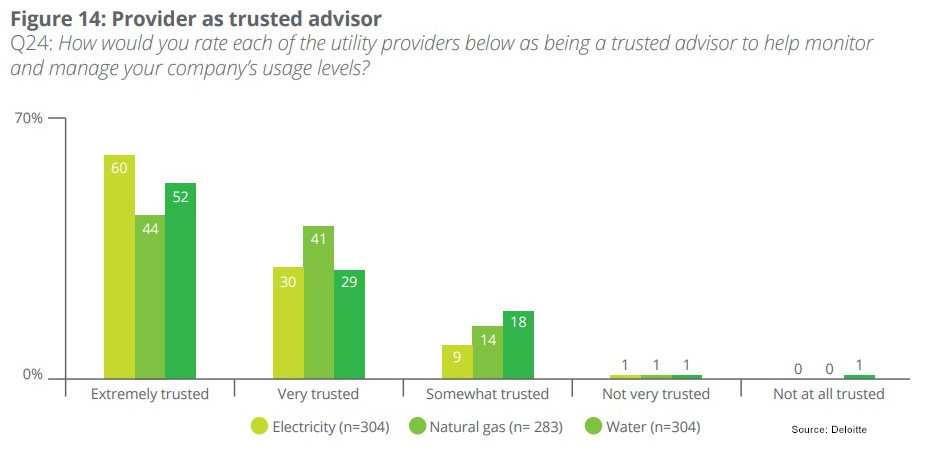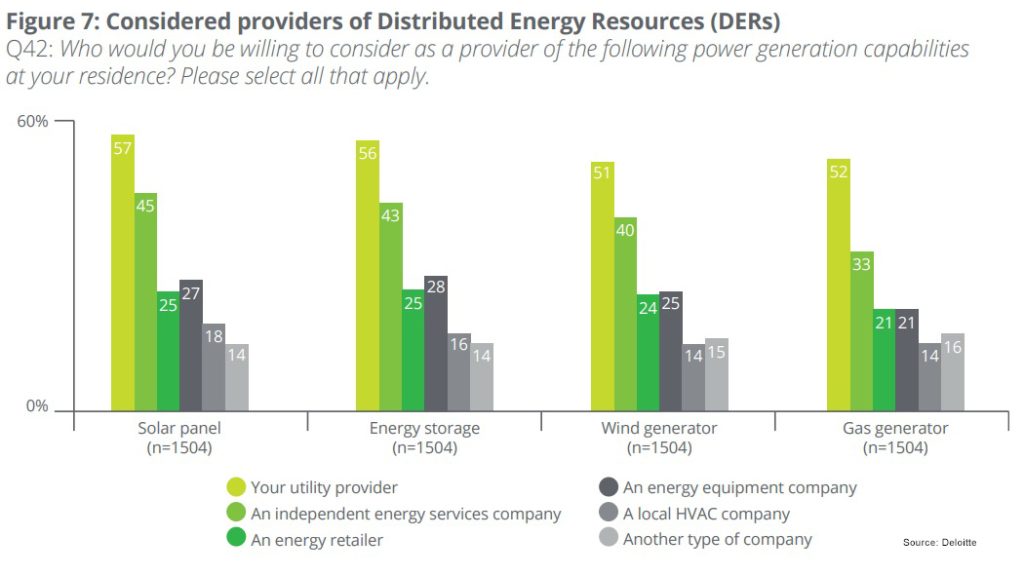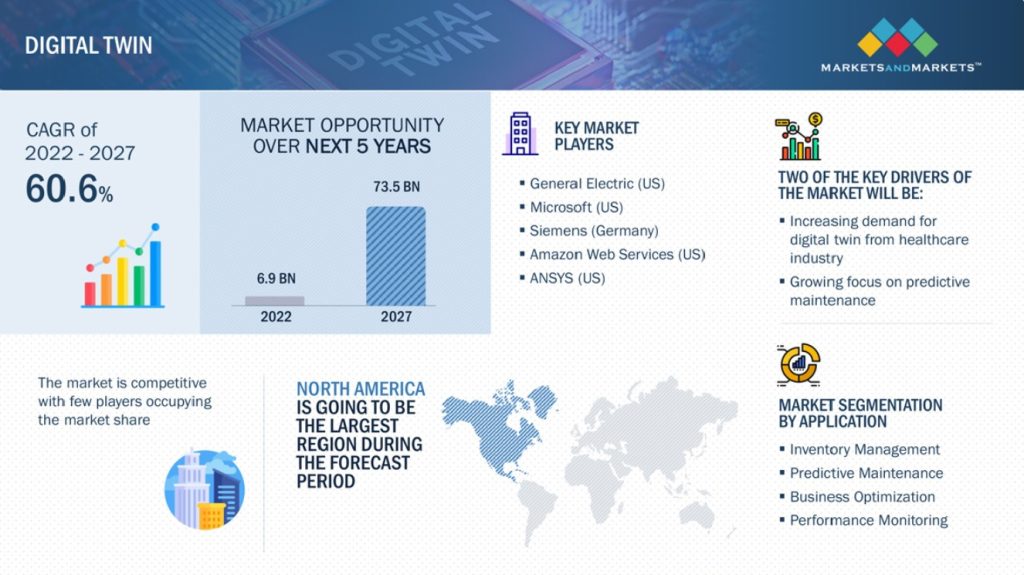How digital twins and other emerging technologies are making grids work smarter.
The electricity grid is a complex, critical infrastructure system, and globally, grids are under tremendous stress. Beyond the typical concerns of addressing reliability, resiliency, and capacity, experts say the grid needs to be “smarter.” How can utilities leverage technology to support the large-scale integration of renewable energy sources like wind and solar power, plus the electrification of transportation? What’s more, how can they do this while ensuring reliability of the power system and delivering the same service to end users?
Emerging technologies are helping infrastructure, including power grids, meet the demands of today and tomorrow. For instance, digital twins—virtual replicas of physical systems—have the potential to transform the way smart grids are built, managed, and operated. By allowing utilities to simulate and optimize operations in realtime, digital twins can bring the electricity grid fully into the connected world.

Emerging Technologies and the Power Grid
Ahmed Mohamed, associate professor in the Dept. of Electrical Engineering at CUNY (City University of New York), head of CUNY’s Smart Grid Interdependencies Laboratory, and associate editor of IEEE Transactions on Transportation Electrification, says the power grid is the most critical infrastructure serving any city. A grid’s failure or destruction has debilitating societal and economic impacts. Current grids are facing tough hurdles.
“Power distribution grids around the globe, in my view, are facing profound challenges,” Mohamed says. “(Challenges) include the imperative to decarbonize the grid by accommodating high penetration of renewable energy in order to combat global warming; the growing electricity demand due to electrification policies—e.g., of transportation and heating sectors; and the need for increased resiliency in the face of low-frequency high-impact events, such as hurricanes and cyber-attacks. These challenges call for a major paradigm shift in grid design and operation.”
One paradigm shift is technology adoption. Mohamed says technologies being applied to the grid right now include ICT (information and communication technologies) and GPS. ICT allows operators to remotely monitor and control the grid, while GPS is enabling technology behind a device, namely a PMU (phasor measurement unit). Going forward, Mohamed anticipates emerging technologies like AI (artificial intelligence), 5G and IoT (Internet of Things), energy storage, blockchain, and digital twins will impact the grid and how it’s operated in the next decade.

Hector Artze, a partner in the energy, sustainability, and infrastructure segment at Guidehouse, says utilities need to invest in new technologies to minimize the impact of DER (distributed energy resources) like EVs (electric vehicles), renewable generation, and energy storage integration. “For example, to manage the voltage impacts associated with EVs, utilities can deploy devices currently available in the market that can be attached to these secondary transformers to manage the voltage locally and thus prolong the useful life of the existing transformers, minimizing the need for their replacement,” Artze says. “There are similar use cases for other smart grid devices that the utilities need to be aware of and incorporate in their asset and investment plans.”
Big data management and business intelligence platforms are also supporting the processing of the data from smart grid sensors to provide actionable information. “These platforms take advantage of the cloud-based enablements, unstructured data, and AI/ML (machine learning) technology for analytics,” Artze explains. “Edge-of-the-grid processing and analytics are now being deployed as well to decentralize analytics to aid with the granularity of information generated by a high number of physical sensors, as well as the timescale/periodicity of information. In some cases, the autonomy of control and action to the ‘local’ grid is available as a feature for utility grid operators.”
Looking toward the future, Artze says T2G (transportation-to-grid), V2G (vehicle-to-grid), and B2G (building-to-grid) technologies and platforms will continue to be more prevalent as EVs, DERs, and building electrification adoption rates increase. “These technology/platforms will help mitigate the impact of integrating the EVs, DERs, and beneficial/building electrification, improve the overall resilience of the grid, and unlock value for both utilities and customers that want to participate,” Artze concludes.

Brad Johnson, senior product portfolio manager for energy at Bentley Systems, points to the fact that there are so many problems facing utilities at once makes it a particularly challenging time. “Every change that they make affects another part of the grid, whether it is the shift to renewable energy, changes at the grid edge with decentralized energy sources, EV charging, increasing demands on the grid from population shifts, changing capacity needs from energy transition, or changes to make resilience and reliability improvements,” Johnson says. “All of these changes emphasize the need for improved access to information across people, processes, and technology.”
A few technology trends Johnson sees as affecting the space right now include the use of reality-captured data (drones, LiDAR, etc.) in both capital projects and for asset inspections, human-assisted automation (e.g., making routine processes and tasks faster and more consistent), and leveraging data from sensors for condition monitoring and assessment. For instance, in the realm of human-assisted automation, Johnson says: “New techniques now allow features to be recognized and classified so that what once was just an object now provides some level of intelligence and connectivity to a database. It allows deeper analysis and adds capabilities for the user to perform operations and maintenance. In addition, we can recognize where there are defects and issues that need to be resolved. Our algorithms provide crack detection in bridges and dams, which can be used in a utility environment to detect where there are potential faults. Another notable example is the ability to automatically detect rust so that maintenance and repairs can be applied before there is a major fault.”
Johnson says digital twins are another emerging technology that, as adoption increases, will empower more engineers, constructors, and owner-operators to design, build, and operate infrastructure assets that are more cost-effective, resilient, and sustainable. From improving the design and analysis of offshore wind projects to continuous dam monitoring and improving the efficiency, safety, and sustainability of grid inspection and maintenance, leveraging digital twins makes infrastructure operations safer and more efficient.
Applying Digital Twins to Electrical Infrastructure
A digital twin of the electricity grid allows utilities to identify potential issues proactively, instead of having to deal with the fallout from issues retroactively. This proactive approach, ideally, allows utilities to prevent issues, improve efficiency, optimize performance, and reduce downtime. A report from MarketsandMarkets suggests the market for digital twins will reach $73.5 billion by 2027, with part of that growth coming from the energy and utilities sector as the space increasingly looks for ways to optimize assets and maximize operational efficiency.

Johan Soderbom, EIT InnoEnergy’s thematic leader for smart grid and storage, describes the current situation as being squeezed from both ends, which is ultimately unsustainable. “There (is) a lot of new generation capacity that is coming into the system, both large-scale wind and solar on higher voltage levels, as well as local production on low-voltage grids,” Soderbom says. “In the ‘other end’, we see a large growth in new loads—both industrial from decarbonization of hard-to-abate industries, such as steel, fertilizer, (and) mining but also from the build out (of) fast charging of heavy vehicles. These new loads will mainly affect the high and mid voltage levels, which definitely puts a new stress on the system.” He says digital twin technologies will be able to enhance operational parameters of the current grid to meet these challenges head on, and they’ll be an excellent complement or alternative to today’s SCADA systems.
Hongjian Sun, professor and head of the Durham Smart Grid Laboratory at Durham University, says the most pressing needs for electricity grids in 2023 include energy affordability, because energy prices are currently dominated by gas prices, and resilience, particularly in light of extreme climate events. Like others, he says emerging technologies to address these issues could include AI, ML, and digital twins. “The powerful side of digital twins is that it allows better understanding of (the) physical world, including the capability of predicative maintenance, likely leading to reduced operational cost,” Sun explains. “(The) second advantage that most people don’t think about is its potential to enable (a) high degree of system integration, including different energy systems, such as gas, heat, and transport.”
Önder Babur, assistant professor in software engineering at Wageningen University and Research and Eindhoven University of Technology, says digital twins are bridging the physical and virtual worlds, and that matters when it comes to the power grid. “The virtual world, which has a long history of development before the recent rise of AI, has resided typically on its own and in compartments—e.g., here’s a fantastic mathematical model of the energy market based on historical data, and we stop there,” Babur explains. “Having the perspective of digital twins urges us to think about connecting the virtual world to the physical (world) seamlessly and bi-directionally. In the ultimate digital-twin scenario, the virtual world has an accurate representation of the physical world, gets updated in realtime on what is going (on), and in turn is able to inform or act on it in realtime and even autonomously, if possible.”
Babur’s colleague at Wageningen, Tarek Alskaif, assistant professor of energy informatics, says the dynamic nature of digital twins could help in the representation of current behavior of electric assets in the grid and, even more importantly, the simulation or prediction of all future scenarios that the electricity grid may encounter, which is usually costly or not possible to be tested on the real grid. Alskaif adds: “Having a trustworthy representation of the electricity grid in the digital twin requires first carefully developing system design and implementation models for the digital twin.”
CUNY’s Mohamed agrees digital twins will substantially improve grid operation. “They will enable us to leverage sensor data so we can estimate things that we cannot easily measure, either due to complexity or cost,” he says. “Digital twins offer digital replica of components or systems. A digital twin can be based on a combination of artificial intelligence tools, mathematical models, sensor measurements, etc. This will enable us to go way beyond our current modeling capabilities.”
3 Real-Life Examples of Digital Twins Enabling Smarter Infrastructure
Brad Johnson, senior product portfolio manager for energy at Bentley Systems, offers three examples from the real world of how digital twins are impacting power infrastructure management:
- Improving analysis and design of offshore wind projects. During the design phase for offshore wind farms, digital twins can simulate wind, wave, and seismic environmental conditions. Keystone Engineering used a digital twin to shorten the design cycle by 50% and save 20% in installation costs.
- Continuous monitoring of dams. To improve survey safety and efficiency, as well as minimize risks inspecting a 160-foot-high dam, HDR created a digital twin that merged architecture, engineering, and construction data with AI across the lifecycle of the structure, identifying current and future maintenance and repair needs.
- Improving efficiency, safety, and sustainability for inspection and maintenance of power lines. Essential Energy created a fully digital workflow for smaller substations plus reality models for design scoping and planning, safety and operational training, and asset conditions to help the company service its more than 52,000 miles of power lines, reduce risk, and automate previously manual processes.
For example, digital twins will enable diagnosis and prognosis of grid-related equipment failures. “We can, for instance, create a digital twin of a battery system, which runs in realtime in parallel with the actual system and can estimate its performance, age, health, etc.,” Mohamed explains. “The inputs can include electrical parameters—voltage, etc., whatever we typically focus on as grid engineers—along with other physical parameters, such as ambient temperature and pressure. The digital twin can help us test control policies before executing them on the actual system, not only limited to evaluating performance of the system but also predict failures and plan maintenance and do postmortem analysis if failures do occur.”
Guidehouse’s Artze further lists three ways digital twin technology can impact the process of building out a smarter grid and power infrastructure. First, he says in the realm of asset management, analytics, and performance tracking: “Digital twins provide the granularity to be able to enable utility asset managers the ability to manage their assets down to the asset level, or if the digital twin model allows, (it) can go down to the component level. As assets are put into operation, a properly modeled digital twin of the asset will be able to receive measured information from field sensors (i.e., field telemetry), log maintenance and operations actions, support information/data for inspection and condition assessment reports, and trigger capital improvements, etc.”
Next, in the realm of asset performance and simulation, Artze says digital twins provide information for scenario simulation to be able to test assets without performing actual “live” tests. Finally, in the realms of customer engagement and customer experience, he says: “Digital twins can provide the necessary information to personalize the utility customers’ interaction/engagement based on the asset performance that impact the level/quality of service to the utility’s customers.”
Applying emerging technologies like digital twins to improve power grid operations, including grid resilience and adaptability in the face of great change, is making the world a better place. “We are all working on important challenges that directly impact the quality of life around the world,” concludes Bentley’s Johnson. “The more improvements made to the grid within their internal processes to create efficiencies, safety, and resilience, and reliability, the better that everyone’s lives are.”
Links for Further Learning:
- Digital twin forecast Markets&Markets
- Digital Twin Technologies in the Electric Utilities Industry
- Digital Twins for Industrial Applications Whitepaper
- Deloitte’s Utility 2.0 whitepaper
Want to tweet about this article? Use hashtags #IoT #sustainability #AI #5G #cloud #edge #digitaltransformation #machinelearning #infrastructure #climatechange #digitaltwins #smartgrid #powergrid #electricitygrid #energy #BentleySystems #Guidehouse #EITInnoEnergy #renewables #EV #electricvehicles #transportation #energystorage #utilities


